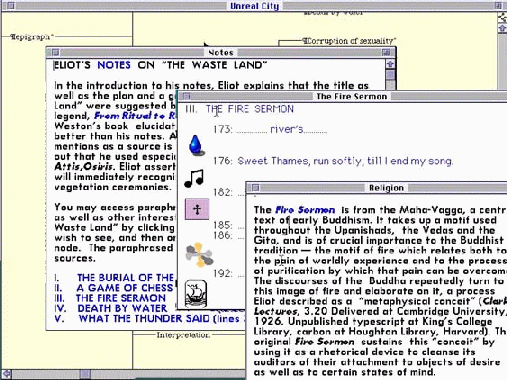 |
| Computers & Texts No.
13 | Table of Contents | December 1996 |
Stuart Lee
Centre for Humanities Computing
University of Oxford
The title 'Unreal City', as most will know, is taken from the repeated line in Eliot's 'The Waste Land'; his classic modernist poem, first published in 1922. 'The Waste Land' has often been the bane of many lecturers, defying simple explanation, and infuriating students by its complexity and apparently deliberate obtuseness. Although Eliot provided his own explanatory notes to the piece, these have proved equally confusing (he himself described them as an 'exposition of bogus scholarship', and one is often tempted to agree with his own declaration that the poem 'is just a piece of rhythmical grumbling').
Faced with this daunting prospect, Christiane Paul, using the hypertext authoring system Storyspace, has attempted to provide a variety of approaches to the poem including background material on the poet's life, critical commentary on the poem itself, and information on source material. The reader can explore the use of myth by Eliot, or follow individual themes such his use of Tarot cards, music, or the Grail legend, via a series of marginal icons.
The poem itself is not presented although the package comes complete with the book Selected Poems by Eliot (Harcourt Brace and Company) which contains a complete version of 'The Waste Land' plus Eliot's notes. The software chooses, instead, to present particular fragments from certain lines which link to explanatory material. These are often paraphrases or expanded versions of Eliot's notes which attempt to help the user understand the complex underlying themes and allusions to other literary material (e.g. in ll. 31-34 the software allows the user to follow a link to Eliot's note of 'V. Tristan und Isolde, I, verses 5-8' but then expands on this by actually providing the context of the quotation in both German and English). As with other Storyspace packages (e.g. Afternoon) the reader is at liberty to create their own paths and connections through the maze of material.
 |
Hypertext notes and thoughts in the Unreal City of T. S. Eliot's 'The Wasteland'.
It is hard to predict how successful this package will be. The links from the poem are useful (any expansion of Eliot's notes are welcome) but occasionally fall into the trap of so many Storyspace applications of simply presenting an annotation without elaboration. Yes, there is reward in forming one's own interpretation of why one piece of information is linked to another, but coming away from the program one feels that an opportunity has been missed. This could have been a more comprehensive user-friendly guide to the poem if it had included more explanatory material.
On the other hand the lack of such guiding material will be welcomed by the more able students who prefer the challenge of interpreting the material for themselves. The whole disjointedness of the hypertext world excellently conveys the feeling of structural decay that runs throughout the poem‹the work itself is almost the perfect hypertext.
In conclusion, this package is worth the investment. Some students may be deterred by the myriad of choices presented to them, but others will find it a perfect medium for the perfect poem.
This review will be published on the Chorus Humanities web site (http://www.chorus.cycor.ca/chorus.html)and has been published here with permission.
[Table of Contents] [Letter to the Editor]
Computers & Texts 13 (1996), 19. Not to be republished in any form
without the author's permission.
HTML Author: Michael
Fraser (mike.fraser@oucs.ox.ac.uk)
Document Created: 7 January 1997
Document
Modified:
The URL of this document is
http://info.ox.ac.uk/ctitext/publish/comtxt/ct13/lee.html